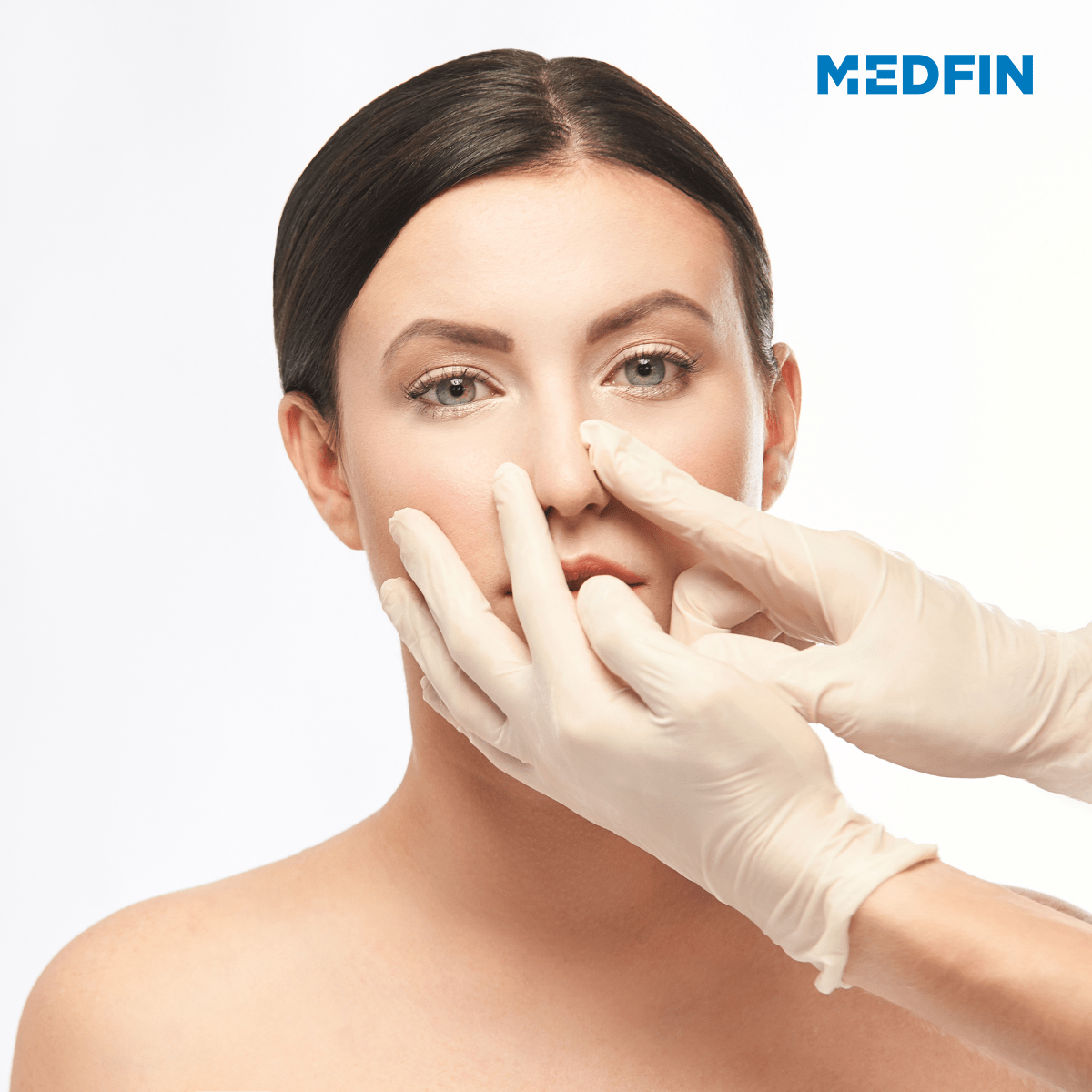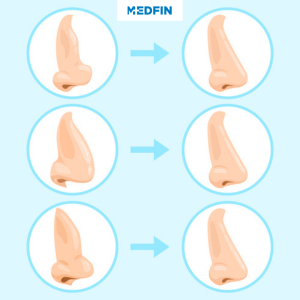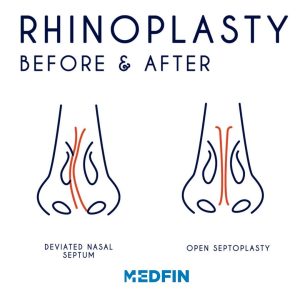Rhinoplasty
Rhinoplasty – All Your Queries Answered

by admin
1st March 2022
5 minutes read
What is rhinoplasty?
Commonly called a ‘nose job’, rhinoplasty is one of the most common plastic surgeries. It involves changing the shape of a nose through modifications in the bone or cartilage. Here’s all you need to know – Rhinoplasty.
Why do people go for rhinoplasty – All you need to know
There are various reasons as to why people choose this surgery. It can be for nose repair after an injury, or to correct breathing problems. It can also be due to birth defects or to get a nose shape of choice. Rhinoplasty can do the following:
- Make a change in the size or angle of your nose
- Straighten the bridge of the nose
- Reshape the tip of the nose
- Narrow down the nostrils
Those wanting to get the surgery for improving appearance should wait for the nasal bone to fully grow. Girls can think of getting the surgery once they are 15, while boys need to wait a bit longer. However, when the reason behind getting the surgery is correction of breathing impairment, a younger age is also fine.
Risks associated with Rhinoplasty – Know it all!
People do ask is rhinoplasty safe or is rhinoplasty painful. No doubt every surgery comes with one or the other risk. Rhinoplasty is no different. And it comes with the following risks: breathing difficulties, a numb nose, nosebleeds, scars, an asymmetrical nose.
A second surgery is also an option for better results once the nose is fully heals from its first surgery. This can take a year. Let us discuss the surgery and rhinoplasty before and after.
Preparations required for the surgery

The preparations for rhinoplasty involve:
- Knowing your expectations and suitability for the plastic surgery
- Examination of your medical history (doctors recommend patients with haemophilia against any elective surgery)
- Physical examination of skin and the inside, outside of the nose (there may be a requirement of blood tests and other lab tests)
- Checking out if any other additional surgery can be done at the same time, for example, chin augmentation
- Taking photographs of the nose from different angles to assess long-term results
- Checking rhinoplasty cost (rhinoplasty for cosmetic reasons will less likely be covered under insurance)
- Avoiding certain medications (aspirin – blood thinner) two weeks before and after surgery
- Avoiding smoking before and after the surgery to allow a good and proper healing process
Procedure
The procedure starts with anaesthesia. It an be general or local. Local anaesthesia is for a simple procedure and can numb the face. The doctor may give medication through an IV line. General anaesthesia involves inhaling a drug or one through IV to make the patient unconscious.
After this, the doctor will make cuts between or inside the nostrils. He’ll separate the skin from cartilage/bone and start reshaping. S/he’ll take additional cartilage, if needed, from the ear, or deep inside of the nose. S/he’ll use a bone graft or an implant, when more needed.
When the septum, or the wall between both sides of nose is crooked or bent, the surgeon may correct it for a better breathing experience.

It can be a one to two hours procedure, that can lengthen more when complicated.
Recovery from the surgery
Once the rhinoplasty surgery is complete, the doctor may place a metal or plastic splint on the nose to help it retain its new shape while healing. Nasal packs inside nostrils may also be applied to stabilize septum, present between the nostrils. Monitoring continues for a few hours till you are allowed to leave later the same day. A one- or two-days stay may be needed in case of a complicated procedure.
Doctors advise resting with the head elevated above the chest. Swollen/packed nose may cause congestion, as dressings need to be in place for a week. Absorbable stitches, however, get dissolved themselves. Non-absorbable ones need you to visit the doctor again.
A few after-effects
A few after-effects or rhinoplasty side effects include slow reaction time, headaches, puffy face and drowsiness. So it is better to have a friend/relative stay with you. Drip pad is used to absorb mucus and blood, which is to be used till a few days after surgery. Medications are also prescribed.
The doctor will tell you to avoid the following:
- Strenuous activities, running and swimming
- Excessive chewing, pulling cloth over head, resting eyeglasses on nose
- Vigorous tooth brushing and facial expressions requiring movement, such as laughing and smiling
- Too much sun exposure to prevent the skin around nose from permanent discoloration
After a week’s rest, one can join school/work again. For the first six months, one may experience swelling, numbness and discoloration, for which cold compresses are the answer. Rest, follow-up care should be continued. Please visit a doctor if any severe symptoms like bleeding, inflammation or pain develop.
It can take a year for you to fully appreciate the results of the rhinoplasty.
At Medfin
We at Medfin, the Surgery expert team, offer you access to the latest and advanced treatment for rhinoplasty surgery at most affordable costs. Our Personal Medfin assistants answer all your concerns related to surgery and ensure that your needs are met in your entire medical journey.
To consult an expert Medfin surgeon near you, please call us on 7026200200. You can also WhatsApp us on 7406557599 (click here to initiate a whatsapp chat).
CATEGORIES
- ACL Reconstruction
- Anal Fissures
- Anal Fistula
- Appendicitis
- ASK A DOCTOR
- Benign Prostatic Hyperplasia
- Breast Lump Excision
- Cataract
- Circumcision
- Conditions & Diseases
- Cosmetology
- Covid-19
- Cure
- Endocrinology
- ENGLISH VIDEOS
- Eye Care
- Gallstones
- General Surgeries
- Government Schemes
- Gynaecology
- Gynecomastia
- Gynecomastia
- Health
- Health Insurance
- Hernia
- hindi
- Hip Arthoscopy
- Hip Replacement
- Hip Replacement Surgery
- Hydrocele
- Kannada
- Kidney Stones
- Knee Arthroscopic
- Laparoscopic
- LASER
- Latest Treatments
- Lifestyle
- Liposuction
- Medfin Stories
- Medicine
- Nephrology
- Ophthalmology
- Orthopaedic
- Paraphimosis
- Patient Testimonials
- PCL Reconstruction
- Phimosis
- Piles (Hemorrhoids)
- Pilonidal Sinus
- Proctology
- Prostate Artery Embolization
- Rhinoplasty
- Second Opinion
- Total Knee Replacement
- Uncategorised
- Urology
- uterine artery embolization
- Uterine Fibroids
- Varicocele
- Varicose Veins
- Vascular
- VIDEOS






